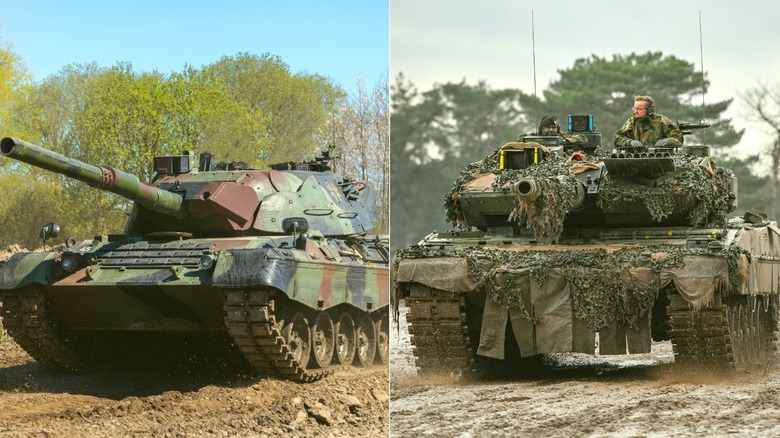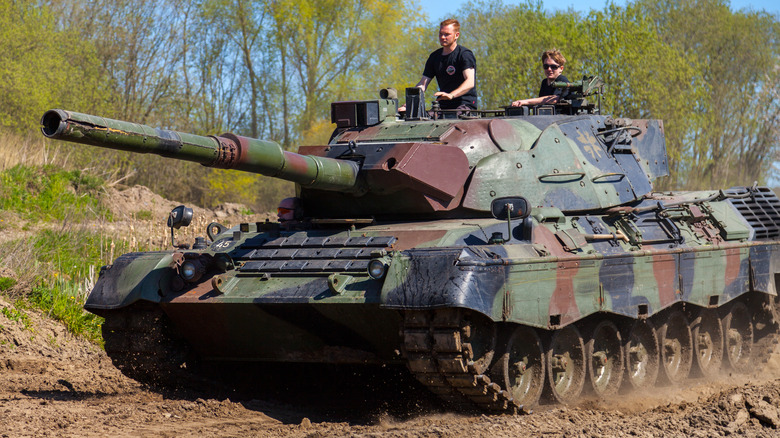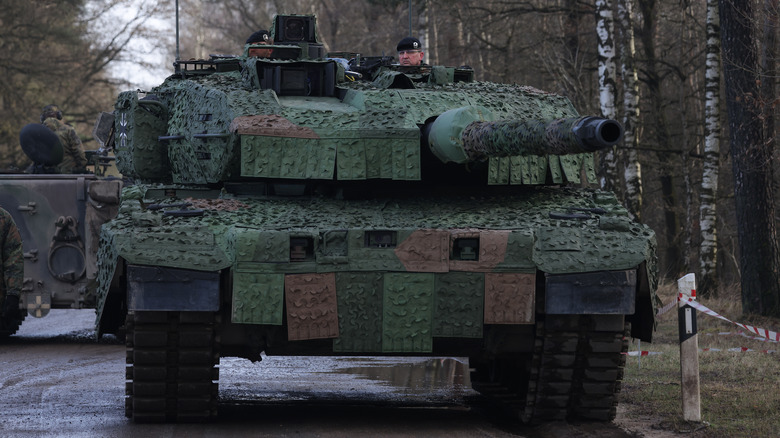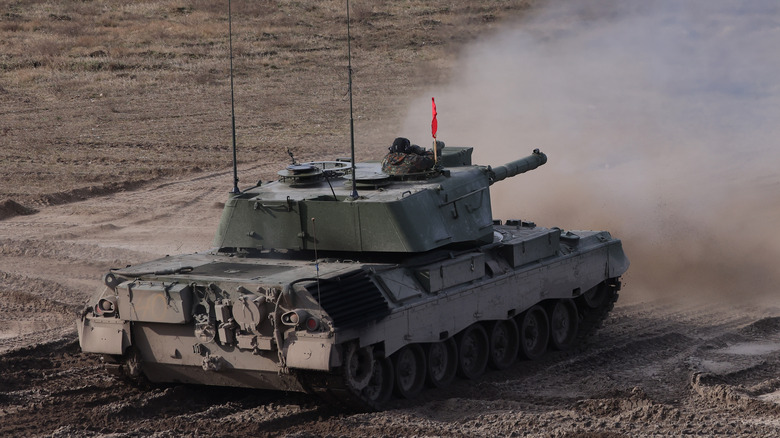The Biggest Differences Between Leopard 1 & 2 Battle Tanks
Nations began building tanks during WWI; since then, tanks have dominated battlefields worldwide. While many nations produce their own tanks, far more purchase or receive tanks from other countries and modify them. This is certainly true of Germany's Leopard 1 and 2 Main Battle Tanks (MBT). The Leopard 1 and 2 are relatively old compared to some of the tanks operating today, but that doesn't make them any less deadly.
Because their development began in the mid to late 20th century, the Leopard 1 and 2 are often considered legacy models when compared to today's modern armor. While this is a factor, both Leopard models have an extensive track record of success in modern conflicts. Several nations used them in support of NATO operations in Afghanistan, and each model succeeded in taking on a variety of threats. This was possible thanks to Germany's modernization program and the fact that the Leopard 1 and Leopard 2 are beasts on the battlefield.
While newer tank models exist, both versions of Germany's Leopard MBT are incredibly versatile and deadly on the battlefield. The tanks are very similar, but their design has several notable differences; the many upgrades they've each had over the years and their operational combat histories differentiate the Leopard 1 from the Leopard 2. Despite their age, both tank models are equally deadly war machines that are more than capable of taking on comparable older models and contemporary armor employed throughout the world.
What is the Leopard 1?
The Leopard 1 entered active service in 1965, so it's an old tank, to be sure. That said, like most Western nations, Germany continued developing its Leopard 1 MBTs throughout their service history, and they've been significantly upgraded to keep pace with more modern designs. The tank's design traded heavier armor for greater lethality, making it fast, agile, versatile, and powerful, and more than 6,400 rolled off assembly lines over the decades.
Germany's Leopard 1 program saw the system updated five times, making the Leopard 1A5 the current operational platform. This upgrade swapped the turret, moved the ammunition stores, included two new sights, improved ammunition, and introduced polycarbonate armor panels to ensure the Leopard 1A5 maintained dominance on the battlefield. The tank's primary gun is a 105 mm rifled Royal Ordinance L7 accompanied by two machine guns.
Since its introduction, numerous nations purchased Leopard 1 MBTs, though Germany phased them out to make way for the Leopard 2. Despite this, they're still used in utility roles in Germany and in combat operations by other nations, which now include Ukraine. While it's easy to assume an older model tank like the Leopard 1A5 isn't comparable to its successor, it has an operational history that cements its status.
What is the Leopard 2?
Germany began producing the successor to the Leopard 1 in 1978 and had produced over 3,500 as of January 2023. The Leopard 2 MBT is a highly sought-after weapon system operated by numerous European allies and Canada. The Leopard 2 incorporates numerous modern advances initially absent in its predecessor. These include appliqué armor, a digital fire control system, enhanced night vision and other optical capabilities, and a 120 mm smoothbore cannon capable of firing modern armor-piercing and high explosive ordnance.
Like its predecessor, the Leopard 2 MBT has undergone numerous upgrades to keep it combat-capable in the 21st century. After all, its development began in the early 1970s, so it's been around for a while. Tanks upgraded to the current Leopard 2A5 altered the shape of the turret, included upgraded composite armor capable of stopping various forms of impact, improved optics, and its main gun has increased pressure, upping its lethality.
Leopard 2s are battle-tested, having served various nations in operations in Afghanistan and elsewhere, so they're a proven commodity. Thanks to modernization efforts, the Leopard 2A5's continued use in combat makes it as reliable as it is lethal. That said, Germany will phase out the Leopard 2 in the near future, making way for another German MBT. Until that happens, the Leopard 2 will continue operations in Ukraine and elsewhere throughout the West.
The verdict
It's easy enough to say the Leopard 2 is the more advanced tank, but that doesn't necessarily make it better. Battle performance is a significant factor in determining a weapon system's viability, and the Leopard 2's combat record has been spotty in recent conflicts, while the Leopard 1's function in combat excelled. Though the Leopard 2's performance history has generally been positive, several factors weaken its ability to operate successfully when compared to the Leopard 1.
A significant problem for the Leopard 2 has been making and maintaining parts to keep the tanks operational. The more complex the tank, the more challenging it is to keep it rolling, and a lack of spare parts to replace and repair the Leopard 2 has hindered its combat effectiveness. Conversely, the Leopard 1 doesn't have as much of a problem in this area, so simply being able to operate for extended periods gives the Leopard 1 a leg-up over its successor.
That said, the Leopard 2's main gun and its armor are superior to the Leopard 1, though experiments mounting the Leopard 2's gun to the Leopard 1 can eliminate the advantage. This effectively levels the playing field, so looking at everything from each model's combat performance, the ability to keep them operational in adverse and austere conditions, and their survivability on the battlefield, the Leopard 1 takes the lead. Ultimately, the Leopard 1's maintenance capabilities give it the edge, though this should favor the Leopard 2 as time passes.



